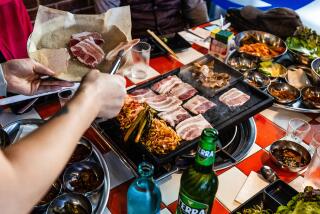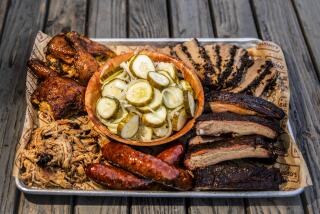Light Up and Lighten Up
- Share via
The smoky smell of grilled meat wafting through parks and back yards, the crunch of potato chips and the pop of beer cans mingling with conversation: These are the sensations of summer. But juicy grilled hamburgers, crusty ribs and mayonnaise-laden salads and coleslaw often lead to pot bellies . . . or thunder thighs on the beach.
There are, however, ways to minimize the damage of a diet of all-American barbecue food without being a drag.
* Appetizers and Side Dishes. To avoid cravings for heavy desserts, start a picnic or barbecue with a chilled soup, maybe gazpacho or cucumber. Or serve salsa and/or humus with pita bread and vegetable dips instead of tortilla chips. Prepare colorful cold dishes that don’t get most of their calories from mayonnaise. Bean, corn, rice or spicy noodle salads are good ideas. Most recipes call for far too much dressing; just thinly coat the ingredients.
* Hamburgers. Even lean ground beef is not particularly lean. In fact, compared with other cuts of trimmed beef, ground beef is one of the fattiest. If you crave meat on the grill, less-fatty cuts include beef or pork tenderloins and sirloin, flank or round steaks. If you crave a burger, deciphering the difference in fat content among ground beef can be hard because there are no consistent definitions for various grinds. Supermarkets set their own names and fat standards.
Generally, if a store identifies its ground beef as “regular,” “lean” and “extra lean” it means that the meat descends in that order by fat content and ascends in price. “Regular” ground beef is the least expensive and the fattiest, while ground round or sirloin are the most expensive and least fatty.
* Hot Dogs. No matter how you pick it, slice it or grill it, a hot dog will never be a low-fat food. Turkey and chicken franks are less fatty than most of their beef and pork counterparts, but they still derive a high proportion of calories from fat. Poultry franks often contain more sodium than meat franks because they have a higher moisture level and thus a quicker spoilage rate. Some chicken and turkey franks contain more cholesterol than meat franks too because poultry skin--a big source of cholesterol--is sometimes added.
* Poultry. What a difference the skin makes--if you eat it, that is. Simple marinades moisten skinless chicken breasts during grilling. Look for recipes that get their flavor from citrus juices, wine, vinegars, herbs, spices and Chinese ingredients such as hoisin or soy sauces or a dash of sesame or hot chile oils. Stuff fresh herbs under the skin and brush with lemon juice and olive oil; the herbs will flavor the meat, and the skin can be removed before eating.
* Seafood. Fish can be grilled whole or as thick steaks rubbed with a dry marinade. Grilling shellfish should kill harmful bacteria.
* Vegetables. Forgo the beef or lamb shish kebab in favor of an all-vegetable skewer. Include chunks of zucchini, yellow squash, eggplant, green, red or yellow peppers, red onions, mushrooms and tomatoes. Make grilled ratatouille by brushing the vegetables with a little olive oil before grilling, then mix them together with a splash of vinegar and/or lemon juice and some chopped fresh herbs. Serve with Italian or French bread, toasted on the grill and rubbed with garlic.
There, now that wasn’t so bad. Have a good Fourth.


